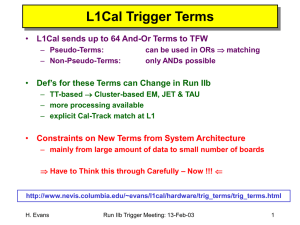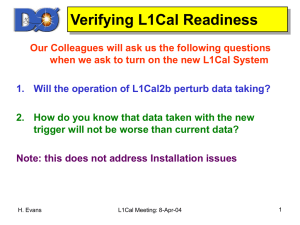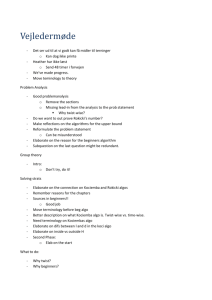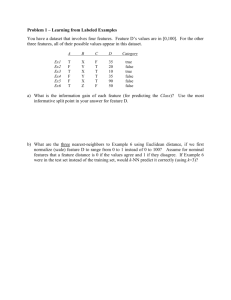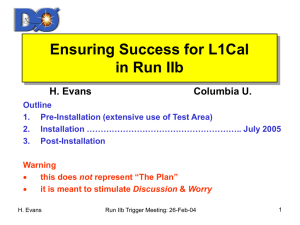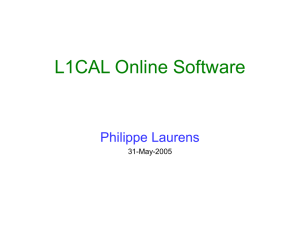New Run IIb L1Cal EM Algorithm Run IIb L1Cal Meeting Greg Pawloski
advertisement
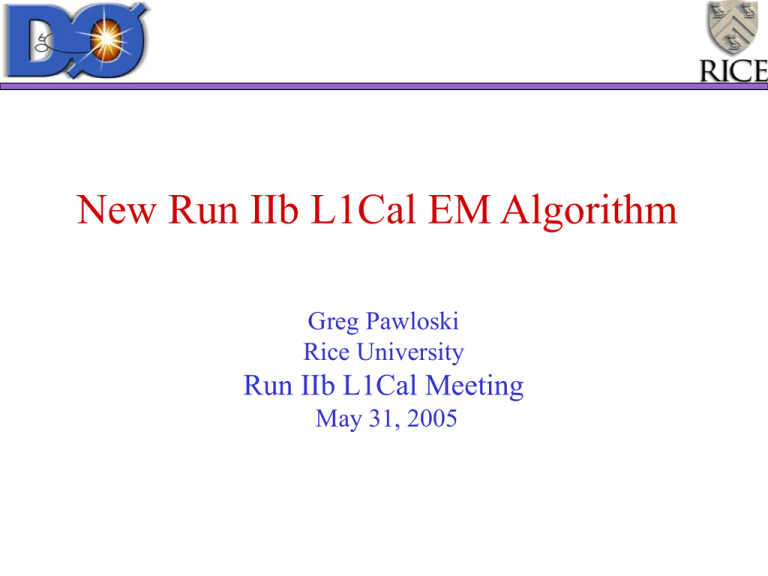
New Run IIb L1Cal EM Algorithm Greg Pawloski Rice University Run IIb L1Cal Meeting May 31, 2005 The Situation The original RunIIb Atlas EM algorithm found trigger objects by looking for a cluster of 2 trigger towers (TTs) that was a local maximum (LM) For an object to be a LM it must: TTs TTs Have a higher Et than all the possible vertical objects in the blue region Phi Eta LM Have a higher Et than all the possible horizontal objects in the blue region Phi Eta same LM Problem: If two electrons are in the blue region then only the highest Et one will be found Greg Pawloski Run IIb L1Cal Meeting 2 Proposed Solutions To overcome this limitation a new style of algorithm was designed that uses an Object Inhibiting Mask instead of LM cuts 3 test algorithms were created: 1. 2. 3. Searches for a seed TT by requiring the TT to have the highest Et in a 3x3 TT area and then finds the highest Et nearest neighbor to form a cluster. Searches for a seed TT by requiring the TT to have a higher Et than its four nearest neighbors (a cross pattern) and then finds the highest Et nearest neighbor to form a cluster. Searches for entire 2TT clusters by looking for vertical and horizontal objects separately. Each test algorithm has a potential weakness (see next slides) Greg Pawloski Run IIb L1Cal Meeting 3 Potential Flaw in Algo 1 The test algo that use a 3x3 search window to find seed TTs still has some cases where it will not find two neighboring electrons > > > > = > > > > For the following configuration of TT Ets 5 10 10 Only this trigger object is found Phi Eta Greg Pawloski 1 Seed TTs must pass this condition Run IIb L1Cal Meeting 4 Potential Flaw in Algo 2 The test algo that use a cross pattern search window to find seed TTs can form an object out of neighboring noise instead of the true signal For the following configuration of TT Ets Only the yellow trigger objects are found Phi -.5 -.25 -.25 .25 -.25 .25 9 10.25 .75 .75 .25 .25 -.25 -.25 Seed TTs are found here The inhibiting mask prevents 2 neighboring horizontal objects from forming Eta Greg Pawloski Run IIb L1Cal Meeting 5 Potential Flaw in Algo 3 The test algo that searches for entire trigger objects will occasionally form a trigger objects that contains the true hot TT, but not the correct nearest neighbor Lots of Et now in isolation region For the following configuration of TT Ets 28 15 1 1 Only this trigger object is found Phi Eta Greg Pawloski Isolation cut will now fail for this electron Algo finds a horizontal 28+15 object and a vertical 28+1 object. The mask removes overlapping objects by choosing the vertical object Run IIb L1Cal Meeting 6 Choosing a New EM algo Conditions for choosing a new EM algo: 1. The new algo must reproduce the old Atlas algorithm’s results when there are no neighboring electrons This will be tested with the CSG Z→ee Data Sample 2. The new algo must out perform the Atlas algorithm when there are neighboring electrons This will be tested with the CSG J/Psi→ee Data Sample Greg Pawloski Run IIb L1Cal Meeting 7 Z→ee Data Sample Et only cuts The new algo w/ the 3x3 search window reproduces the Atlas algorithm exactly The others are less efficient Greg Pawloski Run IIb L1Cal Meeting 8 Z→ee Data Sample w/ isolation and em fraction cuts Again, the new algo w/ the 3x3 search window reproduces the Atlas algorithm exactly Trigger object w/ wrong NN kills isolation efficiency Greg Pawloski Run IIb L1Cal Meeting 9 J/Psi→ee Data Sample Et only cuts For the same rate the new algos are more efficient than the Atlas For the trigger term CEM(2,3): Atlas is ~74% efficient The new algos are ~94% efficient Greg Pawloski Run IIb L1Cal Meeting 10 J/Psi→ee Data Sample w/ isolation and em fraction cuts For the same rate the new algos are more efficient than the Atlas Greg Pawloski Run IIb L1Cal Meeting 11 Conclusion The test EM algo that uses a 3x3 search window would be the best choice for a new EM algorithm It reproduces the old Atlas when there are no neighboring electrons It out performs the old Atlas algorithm when there are neighboring electrons This algorithm is also known as “Algo 4” on the DØ Run IIb Level 1 Calorimeter Trigger website: http://www.nevis.columbia.edu/~evans/l1cal/algos/em_algo/working/em_comp.html Greg Pawloski Run IIb L1Cal Meeting 12
